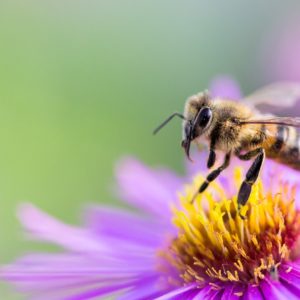Inhaltsverzeichnes
How to create a bee-friendly garden
There is a massive shortage of bees in urban areas as concrete, pavements and infrastructure do little to attract them- yet they play a vital role in gardens. The type of garden which bees are attracted to is typically an overgrown, flowering and fragrant type cottage garden. Think overgrown cottage gardens or scented gardens.
Sadly hybridised and seasonal exotics like pansies aren’t going to cut it for these critters – hybridised plants don’t have the high nectar (carbohydrates) and pollen (protein) content and have lost most of their scent to make way for unnatural colours and varied flower structures.
Each flower has a unique scent and bee’s favourite colours are blue-mauve and yellow. They like the plants planted in bulk and close together. They also need plants that flower at different times of the year so they have a year-round food supply – Little tip: aloes and kniphofias keep hives going in winter.
Here is a list of sweetly scented, brightly coloured local plants that are known to make bees wings buzz.
https://www.facebook.com/LifeGreenGroup
https://www.facebook.com/BotSocSA
SHRUBS
Pink mallow
This ballerina-like plant flowers with grace all year round, providing endless pollen for the bees, and are eye candy in your garden!
Cross-berry
If the seeds of this plant are used to sweeten milk in African cultures… imagine what the flower can do for honey!
Cork bush
Botanical purple, this bush is a fine garden specimen that attracts bees, birds, butterflies and insects- it’s their fast food restaurant in the Highveld.
Puzzle bush
The puzzle bush is alive with activity and its twisted branches and sweetly scented blossoms attract swarms or six-legged creatures, including bees.
Other shrubs to look out for are the buddleja and bauhinia species.
TUBULAR FLOWERS
Aloes
Ensure you purchase indigenous non-hybrid versions that naturally have high nectar content for the sunbirds and bees. Aloes will keep your bee garden alive in winter. http://pza.sanbi.org/search?s=Aloe+

Red hot poker
Who doesn’t love a red-hot-poker, like the aloes, it too flowers in harsh times and is a real head turner in a garden and the bees have taken notice.
Cape honeysuckle
The Cape honeysuckle keeps the bees busy with their lovely yellow, red or orange blossoms, these beauties also make for a fine garden shrub or bush with some shear work.
Clivias
For those shady areas! With all these sun loving shrubs you need something that keeps the shady areas bee-friendly too and this is truly a magnificent local species the bees and gardeners alike simply love.
DAISY-LIKE FLOWERS
Vygies
This flourishing ground cover produces sweet little flowers, and is not only a must have in a succulent garden, it is highly adaptable and is vital in a bee-friendly garden.
Kingfisher Daisy
Felicia plants are already a much loved garden species and now there is a reason to plant more of this blue and yellow daisy bush in your bee-friendly garden.
Bush Daisy
(Euryops)
Looking to add a sunny statement to your bee garden? Try any of the three Euryops daisies and they will be sure to cheer the bees up too!
African Daisy
Related to sunflowers the African daisies are what attract countless tourists to the Namaqualand every spring and it doesn’t just have the tourists and locals running, bees love them too!
Carpet Geranium
The symbiotic relationship doesn’t get any sweeter than that between the carpet geranium and bees. With regards to geraniums try ensure it is the original species and not a hybridised version sold in some nurseries.
Cape Daisy
(Osteospermums)
Make sure you have a less hybridised version but the Cape daisy, making for a beautiful bee garden addition! It will put a smile on your face and Barry the Bee’s too!
Other indigenous plant families that you can use in a bee garden are: Pelargonium, Salvia, Scabiosa, Helichrysums, Gladiolus and Agathosma
FYNBOS
If in SA, you have to try fynbos honey- it’s delicious! The Cape Floral Kingdom is home to thousands of prolifically flowering plants from proteas, pincushions, spiderheads and blushing brides to an array of ericas and many others in between that provide much needed pollen to bees.
You cannot go wrong with an indigenous fynbos garden for the bees, especially if your garden has lots of proteas and ericas.

And don’t forget shallow birdbaths for water.
May your gardens be indigenous, buzzing and beeautiful, creating havens for our precious bees.
Don’t forget to like the Botanical Society of SA on Facebook and follow us on Twitter too.
Information sources
To read up more about the mentioned species, we recommend you visit PlantZAfrica.
There are fantastic related resources and updates on research available from the SANBI Biodiversity Research, Assessment and Monitoring Division here.

Videos
https://lebona.de/bee-friendly-trees-south-africa/
https://lebona.de/10-facts-you-didnt-know-about-fynbos/
















